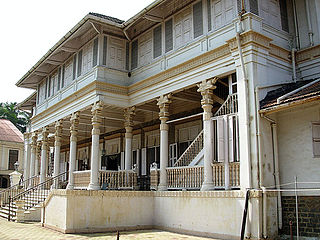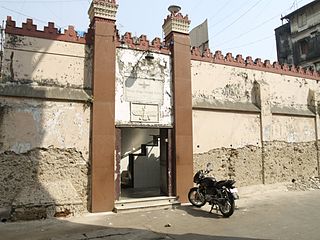Related Research Articles

The Parsis or Parsees are an ethnoreligious group of the Indian subcontinent adhering to Zoroastrianism. They are descended from Persians who migrated to Medieval India during and after the Arab conquest of the Persian Empire to escape religious persecution. The Parsi people comprise the older of the Indian subcontinent's two Zoroastrian communities vis-à-vis the Iranis, whose ancestors migrated to British-ruled India from Qajar-era Iran. According to a 16th-century Parsi epic, Qissa-i Sanjan, Zoroastrian Persians continued to migrate to the Indian subcontinent from Greater Iran in between the 8th and 10th centuries, and ultimately settled in present-day Gujarat after being granted refuge by a local Hindu king, Jadi Rana.

A dakhma, also known as a Tower of Silence, is a circular, raised structure built by Zoroastrians for excarnation, in order to avoid contamination of the soil and other natural elements by the decomposing dead bodies. Carrion birds, usually vultures and other scavengers, consume the flesh. Skeletal remains are gathered into a central pit where further weathering and continued breakdown occurs.

A fire temple, Agiary, Atash Kadeh, Atashgah (آتشگاه) or Dar-e Mehr is the place of worship for the followers of Zoroastrianism, the ancient religion of Iran (Persia). In the Zoroastrian religion, fire, together with clean water, are agents of ritual purity. Clean, white "ash for the purification ceremonies [is] regarded as the basis of ritual life", which "are essentially the rites proper to the tending of a domestic fire, for the temple [fire] is that of the hearth fire raised to a new solemnity". For, one "who sacrifices unto fire with fuel in his hand ..., is given happiness".
Sanjan is a town situated in Umargam taluka in the Valsad district in the state of Gujarat, India. Sanjan is located around 70 km from the Valsad city. It is the earliest settlement of the Parsis in India.
Navsari is the ninth biggest city in the state of Gujarat in India. It is the administrative headquarters of Navsari District. Navsari is situated between Surat & Mumbai. Navsari is a twin city of Surat. It is located 37 km south of Surat. As per 2011 Census of India, Navsari is 16th biggest city of Gujarat state. It ranked 10th most populous city of Gujarat in 1991 Census of India and 2001 Census of India. Navsari is the 25th cleanest city of India according to the Swachh Bharat Urban mission. Dandi village near Navsari was the focal point of the great Salt March led by Mahatma Gandhi during civil disobedience movement of India.

The Irani are an ethno-religious community in the Indian subcontinent; they descend from the Zoroastrians who emigrated from Iran to British India in the 19th and 20th centuries. They are culturally, linguistically, ethnically and socially distinct from the Parsis, who – although also Zoroastrians – immigrated to the Indian subcontinent from Greater Iran many centuries prior, starting with the Islamic conquest of Persia.

The Story of Sanjan is an account of the early years of Zoroastrian settlers on the Indian subcontinent that was originally written in 1599 CE by Parsi priest, Bahman Kaikobad. In the absence of alternatives, the text is generally accepted to be the only narrative of the events described therein, and many members of the Parsi community perceive the epic poem to be an accurate account of their ancestors.

Maneckji Limji Hataria (1813–1890) was an Indian scholar and civil rights activist of Parsi Zoroastrian descent, who took up the cause of the Zoroastrians of Iran.
Udvada is a town situated in Pardi taluka in the Valsad district in the state of Gujarat, India. Udvada is a coastal town located around 24 km from the Valsad city. The Zoroastrian temple, Udvada Atash Behram is situated here.

The persecution of Zoroastrians has been recorded throughout the history of Zoroastrianism, an Iranian religion. The notably large-scale persecution of Zoroastrians began after the rise of Islam in the 7th century CE; both during and after the conquest of Persia by Arab Muslims, discrimination and harassment against Zoroastrians took place in the form of forced conversions and sparse violence. Muslims who arrived in the region after its annexation by the Rashidun Caliphate are recorded to have destroyed Zoroastrian temples, and Zoroastrians living in areas that had fallen under Muslim control were required to pay a tax known as jizya.
Variav is a village in Surat District, Gujarat, India. Variav is on the right bank of Tapti River. Variav was recently added to the region of Surat Municipal Corporation, and is now a suburb of Greater Surat.
Zoroastrianism is recognized in the Baháʼí Faith as one of nine known religions and its scriptures are regarded as predicting the coming of Baháʼu'lláh. Zoroaster is included in the succession of Manifestations of God. The authenticity of the Zend Avesta is seen as uncertain.

Zoroastrianism in India has significant history within the country. Zoroastrians have lived in the Indian subcontinent since the Sasanian period. The Zoroastrians also moved to India in successive migrations during the Islamic period. The initial migration following the Muslim conquest of Persia has been canonized as a religious persecution by invading Muslims. Zoroastrianism meanwhile suffered a decline in Iran after the conquests. Subsequent migrations also took place after the attempts by Safavids to convert their subjects to Shiism.

The Iranshah Atash Behram, also known as the Udwada Atash Behram, is a sacred fire housed in a temple in Udvada, Surat district, Gujarat on the west coast of India. The Atash Bahram, meaning "Victorious Fire", is the oldest fire temple in India, dated to the eighth century, and represents the historical cultural and religious links with Iran. The current temple housing the sacred fire was built in 1742 by Motlibai Wadia from Bombay. The temple structure, built spaciously, is well decorated and contains the Dasturji Kaiyoji Mirza hall and a museum. The main hall of the temple is accessed through a two-stage staircase. The temple attracts Zoroastrian pilgrims from all parts of India, Pakistan, and from around the world.
There was communal violence between Parsis and Bharuchi Sunni Vohra Muslims in May 1857 in Broach in India.

The Revayats are a series of exchanges between the Zoroastrian community in India and their co-religionists in early modern Iran. They have been ascribed the same importance of the Talmud to Judaism by Jivanji Jamshedji Modi.

Banaji Limji Agiary is the oldest Zoroastrian fire temple in Mumbai, India that was constructed in 1709. The fire was consecrated here by the Parsi businessman Seth Banaji Limji. The temple has a fortress-like structure and non-Parsis are not allowed to enter, as in all Zoroastrian temples. The temple is a Grade II heritage structure. Situated less than a kilometre away from the temple, Maneckji Seth Agiary (1733) is the second-oldest fire temple in Mumbai.

Sharifabad, Ardakan is a township in the Central District of Ardakan County, Yazd Province, Iran. It is located near the county capital, Ardakan, and had a population of 4,000 as of the 2006 census. Sharifabad is one of the Zoroastrian centres of Iran, home to numerous Zoroastrian holy sites. Every summer, thousands of Zoroastrians from around the world gather here on pilgrimage. Sharifabad is also notable for the 1,000-year-old Qutbabad aqueduct that runs through the village. The village is home to both Muslims and Zoroastrians who worship separately and respect each other's beliefs.
References
- ↑ "Maneckji Limji Hatari in Iran". Zoroastrian.org.uk. Retrieved 31 May 2018.
- ↑ Eduljee, Ed. "Parsi-Zoroastrian Settlement. Surat. Page 3". www.heritageinstitute.com.
- ↑ Population of Overseas Indians mea.gov.in